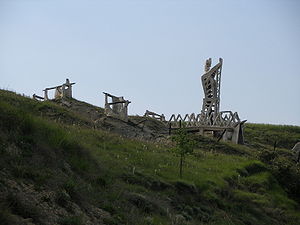| Battle of Noain-Esquiroz | |||||||
|---|---|---|---|---|---|---|---|
| Part of the Italian War of 1521-26 | |||||||
 Present day monument on the battlefield. | |||||||
| |||||||
| Belligerents | |||||||
|
|
| ||||||
| Commanders and leaders | |||||||
|
Iñigo Fernández de Velasco Antonio Manrique de Lara | André de Foix | ||||||
| Strength | |||||||
| more than 30,000 | between 8,000 and 10,000 | ||||||
| Casualties and losses | |||||||
| 300 dead | more than 5,000 dead | ||||||
| |||||
The Battle of Noáin or the Battle of Esquiroz, fought on June 30, 1521 was the only major battle in the Spanish conquest of Iberian Navarre. It was a decisive victory for the Spanish against the invading Franco-Navarrese army.
Prelude[]
Navarre had been conquered by Ferdinand II of Aragon in 1512 and united in 1515 together with Aragon and Castille in the Kingdom of Spain. The son of the former King of Navarre, Henry II had already made three attempts to recover his Kingdom, when he invaded again in 1521, taking advantage of the absence of the Spanish army, dealing with the Revolt of the Comuneros.
He sent a large French/Navarrese army commanded by General André de Foix, Lord of Lesparre, (or Asparros or Esparre) across the Pyrenees, consisting of 12,000 infantry, 800 mounted knights, and 29 pieces of artillery. With the support of the population, in less than three weeks, all of Navarre was conquered. The only opposition came from Ignatius of Loyola's Castilian garrison of Pamplona. He in turn was severely wounded, trying in vain to defend the city castle. The army then moved into Castille, besieging Logroño.
In the meantime the Revolt of the Comuneros had been crushed at the Battle of Villalar in April, and the Spanish were able to gather a huge army of 25,000 men and moved on Navarre. On June 11, Lesparre abandoned his siege of Logroño and retreated back into Navarre. On June 30, both armies met in front of Pamplona.
The Battle[]
The battle was fought in the extended plains between Noáin and Pamplona. The Spanish troops had grown to more the 30.000 men under command of Iñigo Fernández de Velasco, Constable of Castile and the Duke of Nájera, viceroy of Navarre.
Despite being seriously outnumbered 3 to 1, the French attacked, surprising the Spanish and gaining some initial success. But then Fadrique Enríquez, Admiral of Castile, moved his cavalry across the Sierra de Erreniega and fell upon the Franco-Navarrese rear guard.
The bloody battle continued for several hours, but finally the bulk of the Franco-Navarrese was forced to surrender, after suffering some 5.000 casualties. André de Foix, wounded at the eyes, was amongst the prisoners. He was later released for a large ransom.
Aftermath[]
This battle decided for good the future of Navarre as part of the Kingdom of Spain. The rest of the country was reconquered in the following days without meeting any resistance. Lower Navarre remained out of the reach of the Spanish and from there some minor attacks were directed on Fuenterrabía between 1521 and 1524, but without permanent success.
There is today a monument on the battlefield, where on the last Sunday of June, supporters for the independence of Navarre meet every year.
The original article can be found at Battle of Noáin and the edit history here.